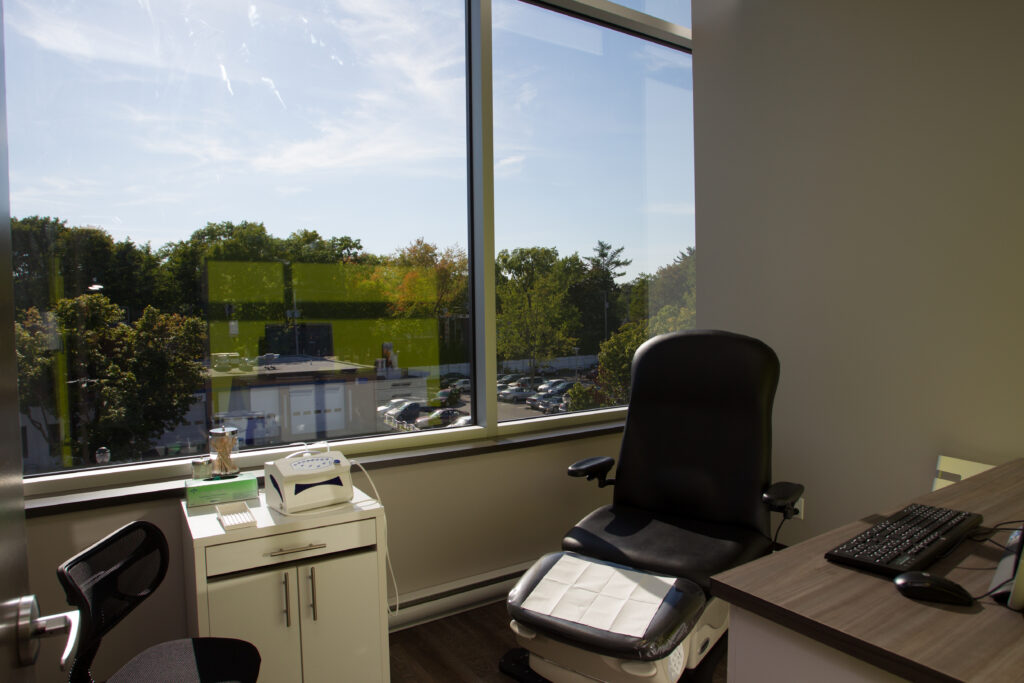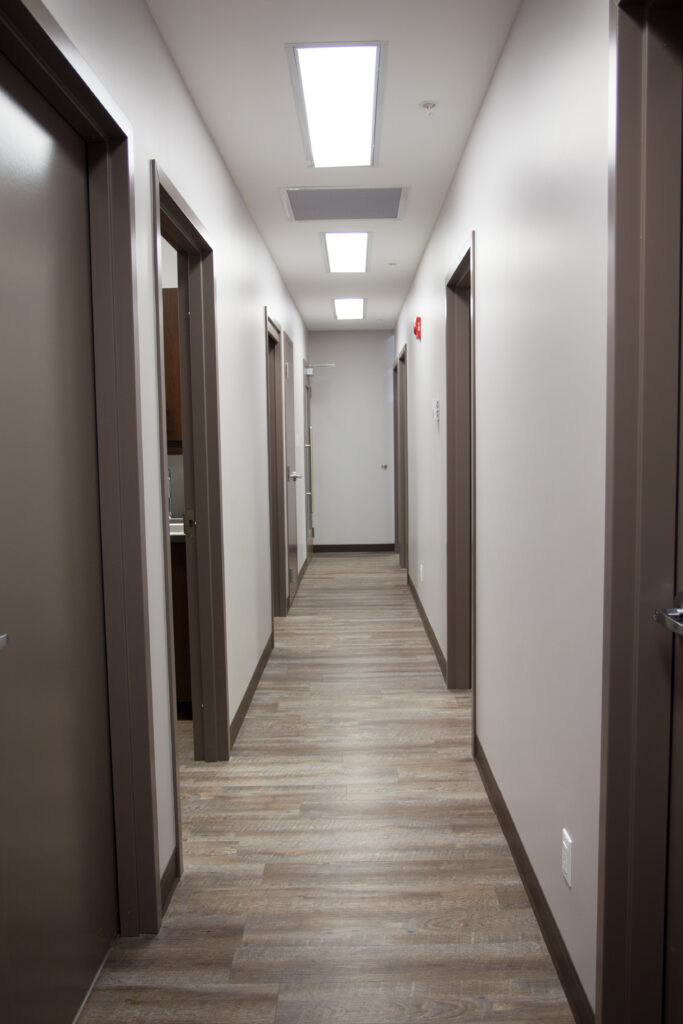The Maguire podiatry clinic is located in Sillery, near Sainte-Foy (Quebec City), offering the most modern and effective treatments to its residents.
Equipped with the latest equipment, the clinic has every tool required to perform specialized treatments to let you get back on your feet as quickly as possible. Whether it’s orthotics, foot care, minor surgery, cortisone injections, or treatment of ingrown toenails and plantar warts, the Maguire clinic has the quickest and most painless solution for you.
When you visit the Maguire podiatry clinic for your foot pain, you can count on the care of a warm and friendly team who will take all the time needed to evaluate your condition and provide you with the best solution. At the Maguire podiatry clinic, there is nothing more important than your well-being and satisfaction.
Maguire podiatry clinic
1444 Avenue Maguire, bureau 301, Ville de Québec, Quebec G1T 1Z3
1-888 293-5464 Toll free
Tuesday : 8:00 - 17:00
Wednesday : 8:00 - 18:00
Thursday : 8:00 - 16:00
Friday : 10:00 - 17:00
Two diligent and passionate podiatrists
Meet the owner of the Maguire clinic: podiatrist Dr. Jessica Paquet-Leblan is a dedicated professional, and a lecturer at the University of Québec in Trois-Rivières (UQTR), where she obtained her own doctorate in 2012.
At her side is the expertise of podiatrist Dr. Ghyslain Delage – also a graduate in podiatry at UQTR. Equally dedicated to his profession, he holds the position of Inspector of the Ordre des podiatres du Québec.
Place your trust into this duo of experienced podiatrists who has the expertise and interpersonal skill to earn your trust. Let them assess, identify and treat all your foot pathologies to provide you with the best care. Call the Maguire clinic today to get back on your feet and rid yourself of pain.




Frequent problems
- Plantar fasciitis: causes, symptoms and treatments
- Foot bunion (hallux valgus)
- Metatarsalgia
- Morton’s neuroma
- Ingrown toenail (onychocryptosis)
- Plantar warts: causes, symptoms and treatment
- Nail fungus (Onychomycosis)
- Corns, calluses and severe corns
- Heel spur (Lenoir’s thorn)
- Diabetic foot
Plantar fasciitis: causes, symptoms and treatments
Plantar fasciitis is a common foot condition. A strain or break in the plantar fascia, the fibrous band that supports the arch of the foot, is at the root of this condition.
Heel discomfort is the most prominent sign of this condition. It will be felt from the first steps in the morning or after a lengthy period of sitting.
You can find plantar fasciitis symptoms, causes, and remedies are listed below.
A person with plantar fasciitis will feel discomfort when they first walk in the morning, but it will subside over the day. They will also experience discomfort after sitting for an extended period of time.
Plantar fasciitis can also cause the following symptoms:
- Pain when palpating your arch or when pressing on your heel;
- Standing or walking causes pain, which might worsen over time;
- Tension on the outside of the foot, which can cause compensating foot and leg discomfort;
- A condition that gets...
Foot bunion (hallux valgus)
Is it difficult to walk on your foot because of a deformity in the big toe area? Is your big toe extending from the base due to the same deformity? Do you have pain and inflammation in your joints?
If this is the case, consult a podiatrist right away because you most likely have a bunion (hallux valgus).
Don't be deceived if the bunion appears to be painless at first.
Hallux valgus can produce a variety of unpleasant symptoms, ranging from minor aches and pains to ingrown toenails and mobility issues.
Here's a rundown of the signs and symptoms of a bunion:
- The appearance of a hump at the base of the big toe caused by a common joint displacement
- Beginning of the displacement of the big toe towards the 2nd toe
- Appearance of joint stiffness and pain when moving straight
- Having trouble putting on shoes (widening of the forefoot)
- Second toe deforms and becomes clawed or hammered
- Joint...
Metatarsalgia
Do you ever get a pain in the foot that makes you feel like you have needles or pebbles in your shoes? If so, you may have metatarsalgia.
This is what we call the pain in the area of the foot sole, between the arch of the foot and the toes. If you have metatarsalgia, you may experience pain in a very localized area or on your entire forefoot.
Metatarsalgia is basically caused by inflammation. Often, the patient who suffers will feel that their socks are always bunched up at the base of the toes. Sometimes they will even feel like they are walking with a pebble or needles in their shoe.
- Burning sensation at the front of the foot
- Swelling of the front part of the foot
- Swelling on the front and top of feet
- Calluses on the front part of the feet
- Difficulty crouching down on bent toes
- Twinge in the foot phalanges
Metatarsalgia can be caused by a number...
Morton’s neuroma
Do you suffer from foot pain that resembles electric shocks in the forefoot, followed by numbness in your toes? If you experience this, it can be symptoms caused by neuroma, also known as Morton’s neuroma.
This problem is due to a thickening of the nerves located between the toes, as a result of compression or friction. This leads to inflammation, numbness, burning or a sensation of small electrical discharges felt in the toes.
Although there is no outward sign of this condition, neuroma triggers several uncomfortable sensations in different areas of the foot.
- Numbness and tingling in your toes
- Sensation of burning in the forefoot
- Sensation of having a bunched up sock under your toes
- Sensation of small electrical shocks in your toes
- Toe cramps
These symptoms are aggravated if you remain standing for long periods of time or if you wear narrow shoes that are not...
Ingrown toenail (onychocryptosis)
Ingrown toenails are a frequent nail issue that can be extremely painful and even incapacitating. It's identified by a toenail that grows into the flesh and punctures it.
Ingrown toenails cause irritation and, in the worst-case scenario, infection, resulting in painful toes.
As a result, it is critical to address the problem as soon as possible in order to prevent the situation from spiralling out of control.
Let's look at the causes, symptoms, and remedies for ingrown toenails.
An ingrown toenail can be identified by a variety of symptoms. Inflammatory redness, pain when squeezed, and, in some circumstances, blood or pus on the side of your nail are all possible symptoms.
However, keep in mind that an ingrown toenail has three stages;
- First stage: there is a small inflammation and pain when pressed.
- Second stage: we observe an infection and the wound becomes more visible.
- Third stage: we...
Plantar warts: causes, symptoms and treatment
A viral infection is what causes a plantar wart, which is a skin lesion. It can either stay dormant for years or develop and spread quickly. It's a contagious skin condition that affects you and those around you.
The HPV, or human papillomavirus, creates these lesions. Despite the fact that it is a harmless virus, it is recommended that you get treatment as soon as possible to get rid of it.
The plantar wart frequently appears as a tiny, rough, spherical, and flat lump. It will manifest itself in a variety of ways.
- Appearance: it consists of spongy, brownish or yellowish tissue with small black dots;
- Size: it can measure from a few millimeters to several centimeters in diameter;
- Pain: plantar warts can be painful, even though they are uncommon. Friction or a pressure point can produce this type of pain, which can become severe;
- Posture problem: the foot pain caused by the plantar wart can lead to a foot positioning...
Nail fungus (Onychomycosis)
If you suffer from a nail infection like nail fungus (onychomycosis), don’t let this problem go untreated. Most often affecting the big toe, it is a fungal infection that causes pain and that is very difficult to treat.
However, if you take the time, it is possible to get rid of it. Read on for further information on nail fungus.
Onychomycosis is a fungal infection, that is, caused by fungi. It causes different symptoms in the affected individual. The main symptoms associated with this podiatric problem include:
- Nail discoloration (it becomes white, yellow or brown)
- Nail that grows thicker, curls up or changes shape
- Nail that breaks more easily
- Painful, infected nail
- Residue under the nail
As mentioned below, it is very difficult to rid oneself of an infection like onychomycosis. So, as recommended by podiatrists, if you suffer from any of these symptoms, do not hesitate to schedule an...
Corns, calluses and severe corns
Corns, calluses and severe corns are formations of dead flesh under the feet. They can be embarrassing for people when they walk or exercise.
Often, people with delicate feet tend to suffer more. However, this foot problem is easily treated.
It is common for an individual to develop skin problems. However, it is important to know the difference between the 3 pathologies described below.
- Corn: this is a localized area of skin that thickens a lot. When a cluster forms, it bores into the skin and causes pain similar to that of a pebble in a shoe.
- Callus: a corn has several names, like callosity or hyperkeratosis. It is characterized by an accumulation of excessive layers of skin and can form cracks in the heel if not treated.
- Severe corn: these are also corns, but in their case, they are more advanced. They are painful, with a brownish center. They develop because of excessive pressure on the skin that has...
Heel spur (Lenoir’s thorn)
When you place your foot on the ground, do you feel discomfort beneath your heel?
Seeing as calcification under the calcaneus is quite common, Lenoir's thorn might be the disease that affects you.
The heel spur, known as Lenoir's thorn, is a bony protrusion on the inside of your heel. This anatomical structure can be seen by X-ray.
People with this condition frequently experience pain in their heels while taking their first steps in the morning or after sitting for a long period. They may also notice a painful spot in their heel, such as a spur.
Imaging is usually used to detect this structure. It is very difficult to feel by touch.
Let's take a look at what makes heel spurs develop, as well as the therapies that can help you get rid of the discomfort they produce.
Heel spurs usually do not cause any symptoms.
When walking or standing for lengthy periods of time, the majority of persons with this...
Diabetic foot
Diabetic foot develops as a result of the neuropathy that comes with poorly managed diabetes. When blood sugar levels are excessively high for an extended length of time, it impairs a person's neurological system.
The injury results in a lack of sensation in the lower limbs, among other things. Peripheral neuropathy is the medical term for this condition.
Blood vessel constriction is also caused by poorly managed blood sugar levels. Wounds and ulcers form more easily and heal more slowly as a result of inadequate circulation.
If left untreated, these two factors explain the dangers of a diabetic foot. A diabetic foot sufferer may have trouble recognizing a wound or a temperature change. As a result, individuals may be unable to discern between discomfort that requires the attention of a podiatrist or other health care provider.
Diabetic foot is a severe disease that can lead to gangrene and, in the worst-case scenario, amputation. That's...
Treatments provided
- Foot orthotics
- Cortisone injections
- Ingrown toenail treatment by a podiatrist
- A podiatrist’s treatment for plantar warts
- Foot care – Nails, corns and calluses treatment
- Biomechanical exam
- Postural evaluation with CryoVizion
- Manual foot therapy
- Evaluating Children’s Feet
Foot orthotics
The primary goal of plantar orthotics is to improve the function of your foot in order to correct various biomechanical flaws or posture issues. They are used to compensate for certain deficiencies in your foot. Because they are custom designed specifically for your condition, the orthosis is perfectly adapted to the shape of your foot to optimize its function.
In addition to relieving any pain you may experience, a custom-made foot orthosis is adapted to the morphology of your feet, and redistributes the pressure exerted on them. It can therefore be used to treat many pathologies and deformities. Remember that the health of your feet is important to be able to perform your daily activities.
To ensure your orthotics treatment provides effective results, the podiatrist will have to evaluate you and design a custom casting of your feet. You will be cared for during all stages of the process, to ensure you receive the correct orthosis, which you can...
Cortisone injections
Cortisone injections, sometimes referred to as “cortisone infiltration,” are often a beneficial podiatry treatment used to relieve acute or chronic pain related to various musculoskeletal issues. Actually, cortisone is a hormone frequently used as an anti-inflammatory to relieve certain joint pains, rashes, inflammation or swelling.
Learn more about cortisone injections, an effective treatment with numerous benefits, but which must generally be used in the short term, with care and discernment, by a healthcare professional.
Ingrown toenail treatment by a podiatrist
An ingrown toenail (onychocryptosis) is an inflammation caused by a portion of a nail (usually on the big toe) penetrating the surrounding skin.
While usually minor, it is nonetheless a common nail problem that can result in pain and inconvenience in your daily life. If the ingrown toenail is not treated, it may lead to inflammation and exacerbate the pain in the foot.
Do not worry, however, as there are a variety of useful therapies available to help you get rid of ingrown toenails and get your feet back on track. Learn more in this article.
Medical nail clipping is one of the most traditional nail care procedures. Nail clipping is a common solution for ingrown toenail problems that is performed by a podiatrist or a specialized nurse (assistant). Professionals in the field of foot care can customize a cut to your nail's condition.
Nail care, on the other hand, is more than simple nail trimming, as antibiotic creams or baths can...
A podiatrist’s treatment for plantar warts
Plantar warts are common skin lesions that can be quite unsightly. They are often harmless, although they can be infectious and unpleasant.
In reality, these growths on the foot might cause bleeding or create other issues such as irritation, pain, or infectious cellulitis in the long run.
Furthermore, if you are diabetic, elderly, or immunosuppressed, your plantar warts are more likely to cause problems.
Fortunately, plantar warts may be treated in a variety of ways to reduce the risk of infection and consequences. Let's have a look at those.
Your podiatrist can write you a prescription for painless wart treatment at home. The majority of these medicines are used topically.
Prescription medication care can:
- Treat plantar warts at home;
- Treat plantar warts completely painlessly.
However, this type of treatment...
- Is usually longer lasting;
- Must be flawlessly...
Foot care – Nails, corns and calluses treatment
Performed by a podiatrist, foot care includes many treatments and assessments aimed at preventing pain, reducing restrictions and promoting comfort. They can even be performed at home by a specialized caregiver.
A versatile professional, the podiatrist uses a variety of treatments to the benefit of your feet:
- Physical treatments;
- Pharmacological treatments;
- Orthopedic treatments;
- Surgical treatments.
A number of cases require foot care to be performed in a professional clinic. Therefore, the podiatrist and their team can provide you with a complete service to prevent and treat your foot pathologies. Naturally, all of this is done with clean, sterilized equipment.
Read on to learn more about the different treatment options.
Among the common foot treatments performed in podiatry you can find:
- The application of special creams;
- The prescription of medicines;
- Foot...
Biomechanical exam
Comprehensive biomechanical examinations are carried out in a podiatric clinic in order to make an accurate diagnosis of your condition. It is thus possible to establish the best possible treatment plan. During your visit, podiatric doctors who provide advanced expertise will evaluate you.
A complete examination done in a podiatric clinic includes:
Postural evaluation with CryoVizion
Postural evaluation is a valuable tool for a complete and accurate evaluation. This computer-assisted system analyzes the light reflected by the body in order to detect any anatomical variations indicative of various pathologies of the feet and the body, without the use of radiation, waves or any other processes that may be harmful to your health. CryoVizion allows the podiatrist to conduct a preliminary objective evaluation of the patient and follow their progress while being treated with plantar orthotics.
Postural imaging makes it possible to:
- Help establish an accurate diagnosis
- Customize treatment for maximum benefit
- Show the benefits of a treatment
- Show how a plantar orthosis is helping your posture
- Measure the feet in a qualitative and quantitative manner
Manual foot therapy
Podiatrists are trained to perform foot mobilizations. They are able to perform an articular evaluation of your feet as well as any symptoms felt. Following this evaluation, the podiatrist designs a personalized treatment plan to improve the articular architecture of your feet.
The podiatrist performs gentle and precise foot manipulations to help improve your feet’s functioning and alleviate your pain. You will thus benefit from optimal biomechanics. Your feet will be better adapted to your daily activities: walking, running, golf, etc.
Evaluating Children’s Feet
Children’s bone structure remains malleable until the growth process is complete. Having your children’s feet evaluated by a competent foot care professional will ensure proper management of any foot pathology that may worsen over the years.
Thus, when taken care of early enough, it is possible to improve your child’s postural development and correct any foot issues for the rest of their lives!
Dr. Jessica Paquet-Leblanc podiatrist
Jessica Paquet-Leblanc, DPM, has been a podiatrist since 2012, and she is also the founder of the Maguire podiatry clinic. The practitioner, who is a member of the Ordre des podiatres du Québec, serves her patients with the most high-quality podiatric care.
Dr. Jessica Paquet-Leblanc, podiatrist, is adaptable and attentive, and she goes out of her way to help you resolve your foot discomfort.
Long-lasting practical and theoretical knowledge
Dr. Paquet-Leblanc, podiatrist and holder of a Doctorate in podiatric medicine from the UQTR, relies on a recognized theoretical training. Furthermore, the proprietor of the podiatry clinic in Quebec City’s Sillery neighborhood did an internship at the famous NYCPM. This several-week internship helped her to hone her abilities in minor foot surgery.
Dr. Paquet-Leblanc, podiatrist, was also quick to get a radiology license in order to provide the most comprehensive podiatric treatment possible. This qualification permits her to detect and diagnose bone problems using digital radiography of the foot.
Jessica Paquet-Leblanc, DPM, does not hesitate to treat a wide variety of patients, from infants to athletes who have lost mobility.
A podiatrist assisting the education of the future generation
Dr. Paquet-Leblanc is a podiatrist, entrepreneur, and instructor at the Université du Québec à Trois-Rivières, with many roles.
Despite her numerous obligations, she makes volunteer trips to the Maison Lauberivière in Quebec City to provide foot care.
Jessica Paquet-Leblanc is a podiatrist who is compassionate and precise in her treatments and will treat your foot discomfort with the greatest regard.
Dr. Ghyslain Delage podiatrist
Ghyslain Delage, DPM, has been treating his patients’ foot pain since 2012. He is a member of the Maguire Podiatry Clinic, he takes every effort to provide his patients with access to the most modern therapy procedures.
A comprehensive approach to podiatry
Dr. Delage is a podiatrist who graduated from UQTR with a doctorate in podiatric medicine. Additionally, this practitioner was able to acquire practical expertise as part of this PhD, most notably during an externship at the renowned New York College of Podiatric Medicine.
Podiatrist Dr. Delage also desired to enhance his field of specialization by earning a radiography license in addition to the skills he obtained at UQTR and NYCPM. This accreditation enables him to detect and treat bone-related pain using digital radiography of the foot.
As an active member of the Ordre des podiatres du Québec, Ghyslain Delage, DPM, participates in continuing education programs that keep him current on technical and theoretical breakthroughs.
The podiatrist, who describes himself as a versatile practitioner, is not afraid to intervene with patients of all ages, from infants to the elderly who are losing their mobility.
A podiatrist who is passionate about his professional order
Dr. Delage, podiatrist, is participating as an inspector for the Ordre des podiatres du Québec out of care for the quality of podiatric care delivered throughout the province. Thus, he contributes to verifying that the therapies advised by his colleagues adhere to the applicable requirements in Quebec.
As an experienced professional, podiatrist Ghyslain Delage will collaborate with you to establish the most appropriate pain management strategies for your condition.
Responsible for personal information/confidentiality: Jessica Paquet-Leblanc 418-914-9222
Request an appointment at the clinic
Leave us your contact details and availability and we will contact you to make an appointment.



